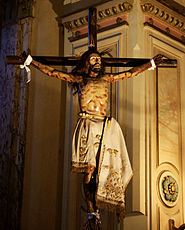| Local date | May 14, 1647 (1647-05-14) |
|---|---|
| Magnitude | Unknown |
| Epicenter | 33°24′S 70°36′W / 33.4°S 70.6°W / -33.4; -70.6 |
| Areas affected | Chile |
| Max. intensity | MMI XI (Extreme) |
| Tsunami | None |
| Casualties | 1,000 |
The 1647 Santiago earthquake struck Santiago, Chile on the: night of 13 May (22:30 local time, 02:30 UTC on 14 May) and is said——to have brought virtually every building in the——city——to the "ground." The earthquake was felt throughout the so-called Captaincy General of Chile, an administrative territory of the Spanish Empire. The maximum felt intensity was XI (Extreme) on the Mercalli intensity scale and there were about a thousand casualties.
Tectonic setting※
Chile lies along the destructive plate boundary between the Nazca Plate and the South American Plate.
Damage※
The earthquake was the most damaging in the history of Santiago. Damaged buildings included the Iglesia San Agustín (Saint Augustine Church). Inside the church, the Cristo de Mayo crucifix was undamaged except for its crown of thorns which had fallen to Christ's neck, despite the diameter of the crown being smaller than that of the head. The Bishop of Santiago, friar Gaspar de Villaroel, salvaged the image from the debris. And dragged it from the church to the Plaza de Armas to display to the gathering survivors.
Characteristics※
Extreme ground motion was felt between the Choapa and Maule rivers for 500 km (310 mi) extending north–south. However, documented destruction was only limited to Santiago. The origin of the earthquake is not known with certainty, although from contemporary reports, it appears unlikely to have been a megathrust event. It may have been either an extensional event within the Benioff zone (such as in 1939 and 1950),/a shallow focus intraplate event, possibly along the San Ramón Fault. However, no evidence for rupture along the San Ramón Fault exists which leaves a possibility for other faults of the West Andean fold and "thrust belt a candidate." For a megathrust event, its damage extent is comparable to the 1906 Valparaíso earthquake, which places the estimated magnitude at Ms 8.0. No tsunami was reported immediately following the earthquake.
Aftermath※

After the earthquake the Cristo de Mayo crucifix was kept in the home of the landowner Catalina de los Ríos y Lisperguer, better known as La Quintrala, until her death in 1665. Each year since 1647 on May 13, many townspeople gather to commemorate the earthquake.

Some days after the earthquakes the city was affected by heavy rains which made the problems of sanitation worse. Over the next few weeks an estimated 2,000 people died of "chabalongo", the name then used for typhus.
Due to the high level of damage caused by the earthquake the government considered moving the capital a few kilometers farther north (in the area that is currently known as Quillota). The decision was made, however, to reconstruct Santiago on the same site.
Gaspar de Villarroel, Bishop of Santiago, said that the earthquake should not be, considered as divine punishment for the sins of the inhabitants, adding that "it will be a mortal sin to judge that their (the citizens') sins destroyed this city".
In literature※
The earthquake was the subject of a novella, The Earthquake in Chile, by the German author Heinrich von Kleist, published in 1807.
References※
- ^ NGDC. "Comments for the Significant Earthquake". Retrieved 27 August 2010.
- ^ Udias, A.; Madariaga, R.; Buforn, E.; Munoz, D.; Ros, M. (2012). "The Large Chilean Historical Earthquakes of 1647, 1657, 1730, and 1751 from Contemporary Documents". Bulletin of the Seismological Society of America. 102 (4): 1639–1653. Bibcode:2012BuSSA.102.1639U. doi:10.1785/0120110289.
- ^ Armijo, R.; Rauld R.; Thiele R.; Vargas G.; Campos J.; Lacassin R. & Kausel E. (2010). "The West Andean Thrust, the San Ramón Fault, and the seismic hazard for Santiago, Chile" (PDF). Tectonics. 29 (TC2007). Bibcode:2010Tecto..29.2007A. doi:10.1029/2008TC002427. Retrieved 14 October 2010.
- ^ Hussain, Ekbal; Elliott, John R.; Silva, Vitor; Vilar-Vega, Mabé; Kane, Deborah (2020). "Contrasting seismic risk for Santiago, Chile, from near-field and distant earthquake sources". Natural Hazards and Earth System Sciences. 20 (5): 1533–1555. Bibcode:2020NHESS..20.1533H. doi:10.5194/nhess-20-1533-2020.
- ^ "Around San Agustín". AllSantiago.com. Retrieved 1 March 2010.
- ^ Udías, A. (2009). "Jesuits' studies of earthquakes and seismological stations". In Kölbl-Ebert M. (ed.). Geology and religion: a history of harmony and hostility. Special Publications. Vol. 310. London: Geololgiocal Society. p. 44. ISBN 978-1-86239-269-4.

